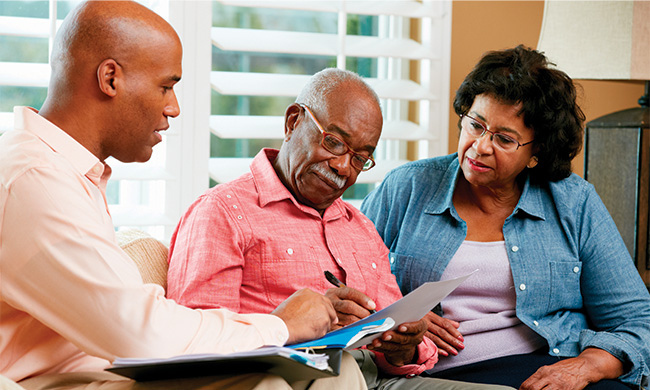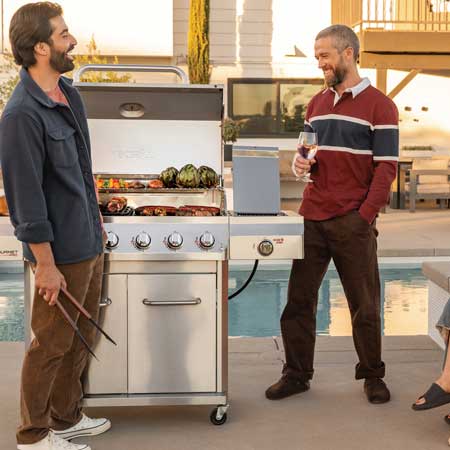Live Better
Smart choices for your health: Resources for selecting a provider

(Family Features) Getting health care for yourself or a loved one is a big responsibility, especially if you’re just getting started with Medicare or have changes in your life, such as a new diagnosis of a condition or disease. It can be overwhelming if you need services like nursing home care, have to find a new doctor or get home health care.
Using online tools like “Find Care Providers” on Medicare.gov can make it easier to make comparisons and help choose doctors, hospitals, nursing homes and more for you or the person you are helping provide care to. Consider these benefits of using the comparison tools to narrow your options.
A Resource for Research
The website provides a simple search and compare experience that allows you to find providers near you. Simply put in a ZIP code and the type of provider to receive a list of providers, their contact information and a map of locations. The information even includes “star ratings” and services provided. The tool can be used to find all sorts of providers, including doctors, hospitals, home health care agencies, skilled nursing facilities, rehabilitation providers, hospice and dialysis facilities.
For example, two sisters needed to find a nursing home that was right for their father. This proved to be a difficult, emotional decision. They didn’t know what nursing homes were in the area where he lives, so they entered his ZIP code and searched for nursing homes. They then received a list of each one in his area, complete with ratings as well as staffing data and inspection reports.
Using a laptop, desktop, tablet or mobile device, you can see how patients rate their care experiences at the hospitals in your area and find home health agencies that offer the services you might need, like nursing care, physical therapy and occupational therapy.
Contact information for local inpatient rehabilitation facilities or long-term care hospitals is available, as well as hospice quality care ratings and specific care details, such as which dialysis facilities offer home dialysis training.
Finding Health Care Services
Many factors influence who you trust with your health care. In some cases, family, caregivers or friends may offer referrals to a doctor or medical facility based on their own experiences, and that can be a helpful guide.
Whether you have referrals or are starting from scratch, you can compare health care providers near you using the Medicare.gov tool, pinpointing which category of services you need, whether it’s doctors and clinicians, hospitals, hospice and home health agencies, dialysis facilities, inpatient rehabilitation centers or nursing homes.
In addition to searching by your location using your address or a combination of city, state or ZIP code, you can search by provider type and keyword to generate a list of providers that could fit your needs.
Finding a Doctor Who Fits
When you’re looking for a new doctor and not sure where to start, the tool makes it quick and easy to find and compare doctors in your area. You can find contact information, practice locations, specialty and hospital affiliation as well as hospital ratings.
Selecting the “compare” button allows you to compare up to three different health care providers at once. When you’re ready to schedule a visit with a new provider, be sure to take time during your scheduling call to verify general information, like the office location, whether the office is accepting new patients with Medicare and whether you need a referral to be treated.
Comparing Nursing Homes
Whether you’re planning ahead or need to make an unexpected decision, there’s a lot to think about when choosing the right nursing home for you or someone else. Many family members and caregivers prioritize location so they’re able to check in and visit frequently, but there are many other important factors you may want to consider, too.
The comparison tool at Medicare.gov provides filtering options that allow you to personalize your results by sifting through the criteria that matter most to you, such as inspection results, number of beds, staffing data and more.
You’ll be able to check out the nursing home’s overall “star ratings.” The information can serve as a guide of a provider’s track record to help assist you with finding a home that best suits the person’s needs.
Visit Medicare.gov/care-compare to access the tool and find health care providers and services in your area that fit your needs.
Paid for by the U.S. Department of Health & Human Services.
Caregiver Guide
Making decisions as a caregiver can be challenging but taking advantage of available resources can help you feel more confident in your choices.
For example, Medicare.gov allows you to find information about health care providers, hospitals, nursing homes, hospice, home health agencies, dialysis facilities, inpatient rehab and long-term care hospitals near you. The website also provides quality ratings, so you can see the provider or facility’s history of service, among other details that help you make the most informed decision on behalf of the person you’re helping.
Photos courtesy of Getty Images
Live Better
5 things funeral directors wish everyone knew

(Family Features) Most people don’t want to think about death – let alone talk about it. When the time comes, families often find themselves overwhelmed, not only by grief but by the many decisions that need to be made quickly.
Funeral directors witness this every day. They see the stress and confusion that can come when there is no plan in place and the peace of mind that comes with thoughtful preparation.
After consulting funeral directors nationwide, the National Funeral Directors Association (NFDA) uncovered five things they wish families knew before a death occurs.
- It’s Never Too Early to Start Planning
While everyone knows death and taxes are inevitable, conversations about death are often avoided.
Simply documenting your wishes and discussing your preferences with your family can alleviate the difficult decisions your loved ones will have to make in the future. Speak with a funeral director to explore the many options for planning a meaningful funeral.
- Legal and Financial Details Can Cause Unexpected Issues
Families often don’t realize power of attorney ends at death, meaning a designated person can no longer make decisions or access bank accounts once an individual dies.
To avoid complications, consider adding a trusted loved one to your bank account and ensure life insurance beneficiaries are up to date. Too often, deceased individuals leave minor children, deceased spouses or former partners as beneficiaries, leading to legal and financial challenges.
- Final Wishes Shouldn’t Be In Your Will
Many people believe the best place to document their final wishes is in their will. However, wills are often not read until after funeral services take place, making them an unreliable way to communicate last requests. Instead, discuss and document your wishes with family members or a trusted funeral professional who can keep your wishes on file until there is a need.
- There Are a Variety of Memorialization Options
End-of-life planning offers more choices than many realize. While burial remains a common preference, cremation is an increasingly popular choice and can even include a viewing and funeral service. Additionally, eco-friendly options, such as alkaline hydrolysis, natural burial and natural organic reduction are becoming more widely available for those seeking green memorialization. In fact, according to NFDA’s 2024 Consumer Awareness and Preferences Study, 68% of respondents expressed interest in green funeral options.
Exploring these possibilities with a funeral professional can help ensure your final arrangements reflect your values, traditions and personal wishes.
- Funeral Directors Don’t Just Manage Funerals – They’re Trusted Guides In Honoring Life
Funeral directors play a vital role in helping families create meaningful services that reflect their loved one’s life, values and traditions. Whether planning ahead or facing a recent loss, funeral professionals provide expertise, compassionate care and personalized guidance during one of life’s most difficult moments.
Choosing the right funeral director is an important decision and finding someone who understands your needs can make all the difference in honoring your loved one in a personal and meaningful way.
Start the conversation today by talking about end-of-life planning. It isn’t easy, but it’s one of the most important conversations you can have with your loved ones. A little planning today can make a world of difference tomorrow.
Use comprehensive resources like RememberingALife.com, which is designed to guide families through every stage of the journey, including planning, funeral options and grief resources. The site offers valuable tools and support, such as the “Find a Funeral Home” tool to connect families with compassionate, local funeral directors and much more.
Photo courtesy of Shutterstock
Live Better
Gear up for grilling season

(Family Features) As the days get longer and the temperatures rise, it’s time to fire up the grill and elevate your outdoor cooking game. Whether you’re a seasoned grill master or just starting out, success comes down to three essentials: quality ingredients, the right seasonings and reliable equipment that gives you full control over heat and timing.
If you’re ready to turn up the heat this season, explore high-performance grilling solutions from Nexgrill – built to match every cooking style and skill level. From backyard barbecues to weeknight dinners under the open sky, its lineup is designed to help you serve up unforgettable flavors all season long. Visit nexgrill.com to learn more and get inspired.

Unlock a New Level of Outdoor Cooking Versatility
Transform your backyard into a chef-inspired kitchen with the Gourmet Pro 6-Burner Stainless Steel Gas Grill featuring the Griddle Max Cooking System. Designed to go beyond traditional grilling, this powerhouse lets you grill, saute, griddle and smoke all at once or on demand. The innovative system makes it easy to achieve restaurant-quality results, delivering unmatched versatility for any meal. Built with stainless steel burners, angled flame tamers and porcelain-coated cast-iron cooking grids, it ensures consistent heat and fewer flare-ups. With 811 square inches of cooking space, six main burners and a high-heat searing side burner, you’ll get 75,000 BTU of total cooking power.

Take on Breakfast, Lunch and Dinner
From sizzling fajitas at your backyard bash to early-morning pancakes before your next adventure, the Daytona 4-Burner Propane Gas Griddle delivers the heat, flavor and performance you need. Designed for versatility, this powerhouse features a 792-square-inch cooktop and four stainless steel burners, giving you the space and control to cook multiple dishes at once. Built-in convenience comes standard with dual side shelves, a lower storage rack to keep tools within reach and a removable grease cup for quick and easy cleanup. When it’s time to pack it in, a heavy-duty lid protects your cooking surface.

From Kitchen to Patio, It Goes Where You Go
Grilling isn’t just for the backyard. When weather or space keeps you inside, the Fuse 22-inch Electric Griddle delivers bold, flame-free cooking anywhere there’s an outlet. Ultralightweight and easy to transport, it’s built for seamless indoor-outdoor use. With 308 square inches of edge-to-edge heat, a durable nonstick surface and digital temperature control, this electric flattop offers precision and power. A hinged lid with a built-in viewing window locks in heat and flavor so you can cook efficiently. From weekday breakfasts in the kitchen to weekend feasts on the patio, it can be your all-access pass to delicious, flexible cooking – wherever life takes you.
SOURCE:
Nexgrill
Live Better
This Mother’s Day, give the gift of giving back

(Family Features) Celebrate Mom and other special women in your life with a Mother’s Day gift that makes a lasting impact for children.
When you shop at UNICEF Market, you’re not only choosing beautifully hand-crafted artisanal gifts, but also supporting its efforts to keep children healthy, educated and safe across 190 countries and territories. A portion of every sale could provide safe water, enhance schools, supply essential services or protect infants from preventable diseases.
Each item, from jewelry and apparel to homeware, is sourced from talented artisans who receive fair prices for their creations, strengthening their communities and supporting their families. In fact, the gifts give back three times over: They support artisans and help communities thrive, assist vulnerable children and make for thoughtful, compassionate Mother’s Day gifts.
Choose a meaningful gift that honors the special women in your life while empowering children with the tools for a better future.
Featured Gifts
- Aqua Handblown Recycled Glass Carafe and Cup Set, ‘Delicate Aqua’
Add a touch of elegance to any space with this eco-friendly carafe and glass set, handblown from recycled glass by artisans in Mexico. Perfect for your home office or bedside table, it’s a beautiful and practical way to support sustainability.
- Handmade Artisan Jewelry
Choose from a stunning collection of handmade jewelry crafted by artisans from around the world, including first-edition Beads of Hope Bracelets from Guatemala. From modern designs to timeless elegance, each piece tells a story of cultural heritage and artistry.
- Unique Home Decor
Bring a global touch to your home with handcrafted decor from Africa, Latin America and Asia. Whether it’s a rustic accent, a Peruvian rug or an African sculpture, these pieces can add character and charm to any room.
Inspired Gifts for Moms and Babies
For a gift that truly gives back, consider UNICEF’s Inspired Gifts. These donations support life-saving programs and can be sent via email or printed as a card. Perfect for those who have it all, these gifts honor the special women in your life while supporting children across the globe.
- Mom and Baby Care
Ensure the safety and well-being of both mother and baby with a package that includes essential medications for a smooth and safe delivery. This gift directly supports the health of moms and babies in need. - Bundle of Hope
Your donation can provide children with the essential tools for learning and growing: clean water, soap, exercise books, pencils, vaccines and therapeutic food. This gift helps ensure all children have the resources they need for healthy, productive futures.
This Mother’s Day, celebrate moms and children around the world with a gift that keeps on giving by visiting market.unicefusa.org.
SOURCE:
-

 NEWS2 years ago
NEWS2 years ago2 hurt, 1 jailed after shooting incident north of Nocona
-

 NEWS1 year ago
NEWS1 year agoSuspect indicted, jailed in Tia Hutson murder
-

 NEWS2 years ago
NEWS2 years agoSO investigating possible murder/suicide
-

 NEWS2 years ago
NEWS2 years agoWreck takes the life of BHS teen, 16
-

 NEWS2 years ago
NEWS2 years agoMurder unsolved – 1 year later Tia Hutson’s family angry, frustrated with no arrest
-

 NEWS2 years ago
NEWS2 years agoSheriff’s office called out to infant’s death
-

 NEWS2 years ago
NEWS2 years agoBowie Police face three-hour standoff after possible domestic fight
-

 NEWS2 years ago
NEWS2 years agoDriver stopped by a man running into the street, robbed at knifepoint






